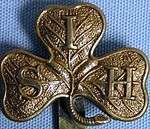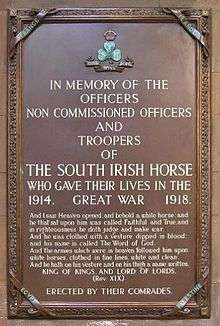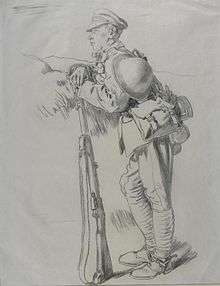South Irish Horse
The South Irish Horse was a Special Reserve cavalry regiment of the British Army. Formed on 2 January 1902 as the South of Ireland Imperial Yeomanry. It was renamed as the South Irish Horse from 7 July 1908 and transferred to the Special Reserve (Cavalry). Having taken part in the fighting of the First World War, it was disbanded in 1922.
| South Irish Horse | |
|---|---|
 Regimental Badge | |
| Active | 1902–1922 |
| Country | |
| Branch | |
| Type | Yeomanry |
| Role | Cavalry |
| Commanders | |
| Current commander | Defunct |
| Colonel-in-Chief | Field Marshal Arthur, Duke of Connaught and Strathearn |
Formation



Following the Second Boer War, sixteen new yeomanry regiments were formed, two of them being from Ireland. King Edward VII approved the formation of the 'North of Ireland Imperial Yeomanry', and a 'South of Ireland Imperial Yeomanry' in 1901. Their formation was sanctioned and gazetted on 7 January 1902.[1] The 'South of Ireland Imperial Yeomanry' was renamed as the 'South Irish Horse' on 7 July 1908 and transferred to the Special Reserve (Cavalry).[2] Squadrons were formed as follows:[3]
- HQ - Artillery Barracks, Limerick
- A Squadron - Beggars Bush Barracks, Dublin
- B Squadron - Artillery Barracks, Limerick
- C Squadron - Glen House, Ballyvolane, Cork
- D Squadron - Beggars Bush Barracks, Dublin
First World War
The declaration of war against Germany in August 1914 found the South Irish Horse at summer camp, as was its sister regiment the North Irish Horse. The Expeditionary Force squadron of North Irish Horse (designated A Squadron), along with its counterpart in the South Irish Horse (designated B Squadron) was assigned to the British Expeditionary Force. Both squadrons sailed from Dublin on the SS Architect on 17 August 1914.[4] More squadrons of the 'Horse' were to join the regiment in France. The South Irish Horse did not stay together as a unit, but squadrons were attached to different formations in the BEF as and when required:
- A Squadron – joined 21st Division in 1915, went to form part of XV Corps Cavalry Regiment in 1916 and became XVIII Corps Cavalry Regiment in 1917.[5]
- B Squadron – moved to France as GHQ Troops in August 1914, joined 2nd Division in 1915 and went to form part of I Corps Cavalry Regiment (and was re-designated S Squadron) in 1916.[5]
- C Squadron – joined 16th (Irish) Division in 1915 and went to form part of I Corps Cavalry Regiment in 1916.[5]
- E Squadron – moved to France and joined 39th Division in May 1916 and then went to form part of I Corps Cavalry Regiment in May 1916.[5]
- F Squadron – moved to France in 1917 and joined XVIII Corps Cavalry Regiment.[5]
- S Squadron – joined 32nd Division in 1915 and went to form part of XV Corps Cavalry Regiment in 1916. It was then re-designated B Squadron. It moved to IX Corps Cavalry Regiment in 1916 and it became XVIII Corps Cavalry Regiment in 1917.[5]
In September 1917, the officers and men of the South Irish Horse were retrained as infantry and formed 7th (South Irish Horse) Battalion Royal Irish Regiment; the battalion formed part of the 49th Infantry Brigade in the 16th (Irish) Division.[6] The battalion was caught in the German Spring Offensive in March 1918: the Official History records that, "two companies of 7th Battalion Royal Irish Regiment, posted in forward zones, suffered terribly; not a man succeeded in escaping."[3]
The regiment was one of the six southern Irish regiments of the British Army disbanded in 1922 following the creation of the new Irish Free State.[7]
Battle honours
The regiment's battle honours were as follows:[2]
- Loos
- Somme, 1916
- 1918
- Albert, 1918
- St Quentin
- Rosières
- Avre
- Ypres, 1918
- Courtrai
- France and Flanders, 1915-1918.
Uniform
The parade dress of the South Irish Horse worn until 1914 included a dark green peaked cap and tunic with scarlet facings. Overalls (tight fitting cavalry breeches)[8] were green with double scarlet stripes.[9]
Regimental Association
The regiment is remembered through the 18th Regiment of Foot Royal Irish Regiment (and South Irish Horse) Association which is based in Clonmel, County Tipperary. Dependents may still get assistance from the Army Benevolent Fund.[10] The Combined Irish Regiments' Association also remains as a source of information and for those who wish to remember the disbanded regiments.[11]
Great War Memorials
- Irish National War Memorial Gardens, Dublin.
- Island of Ireland Peace Park Messines, Belgium.
- Menin Gate Memorial Ypres, Belgium.
- Ulster Tower Memorial Thiepval, France.
References
- "No. 27395". The London Gazette. 7 January 1902. p. 151.
- "South Irish Horse". Regiments.org. Archived from the original on 19 August 2007. Retrieved 14 October 2017.CS1 maint: BOT: original-url status unknown (link)
- "South Irish Horse". Combined Irish Regiments Association. Retrieved 14 October 2017.
- Hughes, Gavin (2015). "Fighting Irish: The Irish Regiments in the First World War". Irish Academic Press. ISBN 978-1785370229.
- Chris Baker (1996–2008). "The South Irish Horse—Regiments of the Special Reserve—North Irish Horse". The long, long trail. Retrieved 28 November 2008.
- "Royal Irish Regiment". The Long, Long Trail. Retrieved 9 April 2016.
- "The South of Ireland Imperial Yeomanry & The South Irish Horse". Southirishhorse.com. Retrieved 3 January 2017.
- Carman, W.Y. A Dictionary of Military Uniform. p. 97. ISBN 0-684-15130-8.
- Smith, R.J. The Yeomanry Force at the 1911 Coronation. p. 29. ISBN 0-948251-26-3.
- "ABF - The Soldiers' Charity". Retrieved 14 October 2017.
- "Combined Irish Regiments". Combined Irish Regiments.
